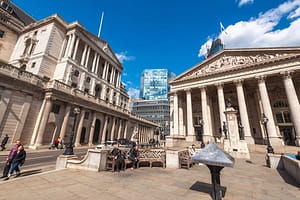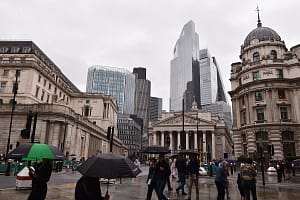Bank of England governor Mark Carney gave his first major address today, clarifying his position on monetary policy and the future of stimulus.
In the speech Carney promised to not lift interest rates from historic lows of 0.5%, until the economic recovery was sufficiently secured, dismissing assertions that rates would rise once unemployment fell to 7% from the current 7.8%.
Falling unemployment would be an indicator not a trigger for raising rates, Carney said, while promising to restore confidence in the ailing British economy.
Here are the highlights of the Nottingham speech, made at a CBI-hosted event:
Interest rates and unemployment:
The 7% unemployment threshold for lifting interest rates is not absolute and will depend on other economic factors. The Bank does not expect unemployment to fall to these levels before 2017, even though recent reports have suggested such levels could be reached as soon as 2015.
Carney said: “The Bank Rate will automatically rise when unemployment falls to 7%. […] The 7% threshold is instead a staging post along the road to recovery. When unemployment reaches 7% the MPC will reassess the state of the economy and the appropriate stance of monetary policy.
“It may seem that unemployment doesn’t have far to fall, from the current 7.8% to the 7% threshold. The MPC’s central view, though, is that this could take some time.”
Carney outlines three reasons why the reduction will be gradual:
>> One: Outlook has improved over the last few months but, growth prospects over the next three years are “solid not stellar”.
>> Two: Many people are not working full time, which means their hours are likely to increase before overall joblessness falls.
>> Three: Productivity rates are expected to keep growing at below historical averages over the next few years, meaning 2008 levels will only be reached in 2015.
Interest rates and savers:
“The prospect that interest rates might stay at their low level for longer will not be welcome for savers.
“I have tremendous sympathy for them – after all they have done the right thing […] but the last thing savers want is for the UK to follow Japan by raising interest rates before recovery is secured – only to find that we are condemned to decades more of low interest rates and lost opportunities.”
Interest rates and inflation:
Inflation targets remain fixed at 2% and are still the Bank’s number one priority, even if a higher-than-target level will be tolerated for some time to come. Interest rates stood at 2.8% in July, down from 2.9% in June.
Carney said: “The Bank of England’s remit recognises that, at times, it is appropriate to bring inflation back to target more slowly in order to avoid unnecessary volatility in output.
“With a depressed level of output and inflation above target due to temporary factors rather than demand pressures, this is such a time.
“If there are any signs of underlying inflation pressures building such that it seems inflation 18-24 months ahead will be 2.5% or more – or if medium term inflation expectations are no longer sufficiently well anchored, then the guidance on interest rates no longer applies.”
- Try our free newsletter
- The LondonlovesTalent Awards: DEADLINE FRIDAY 13 SEPTEMBER
Interest rates and the bond markets:
Long-term bond yields of advanced economies have experienced upward pressure in recent months, but this is not justification to increase interest rates.
Carney said: “The main common driver [of the generalised upward move] is speculation that the US Federal Reserve will soon reduce the pace of its asset purchases.
“That has – not surprisingly – affected yields in other countries because safe, liquid sovereign bonds of the world’s largest economies are close substitutes for each other.
“In the UK, these movements have been reinforced by growing expectations of recovery. As we explained at the time of the forward guidance announcement, a rise in the yields on long term bonds is consistent with our commitment to price stability and supporting the recovery.”
In the short to medium term, however, market interest rates in terms of two to five years have also risen recently.
Carney added: “The date at which the markets expect the first increase in Bank Rate has moved in from the end of 2015 to mid-2015. One possible explanation is that markets think that unemployment will come down to 7% more quickly than we do.
“And we estimate there is only a 1 in 3 chance of unemployment coming down that quickly.
“Movements in longer-term market interest rates are certainly relevant, but what matters most to you is what actually happens to Bank Rate, now and in the future. That is because the interest rates on 70% of loans to households and more than 50% of loans to businesses are linked to Bank Rate.”
Interest rates and the banks:
Interest rates should stay low to help the banks get on their feet so they can start lending again.
Carney said: “The UK also needs a fit and healthy financial sector. It plays a vital role in generating services output in the UK, creating jobs and in exporting to the rest of the world.
“To serve the needs of the wider economy by extending credit to where it is needed, banks must command the confidence of their customers and investors.
“That is why a second element of the Bank of England’s strategy is to ensure that banks reach a clear threshold of good health.
“Some argue that the repair of banks’ balance sheets holds back economic recovery because it causes banks to cut back their lending. The reality is the opposite: where capital has been rebuilt and balance sheets repaired, banking systems and economies have prospered.
“That threshold, a capital base of 7% of their risk-weighted assets and at least 3% of their total assets, must be crossed if the system is to be able to support and sustain the recovery. Some of the UK’s major banks had already crossed it, and over the summer we have made sure that the others put in place plans to reach it.
“Accordingly, I can confirm today that, for major banks and building societies meeting the minimum 7% capital threshold, the Bank of England will reduce the level of required liquid asset holdings. The effect will be to lower total required holdings by £90bn, once all eight major banks and building societies meet the capital threshold.
Interest rates and the housing bubble:
Concerns have been growing that increased mortgage lending and spiralling house prices risk causing a housing bubble, similar to what we saw pre-recession, but the Bank of England thinks that the concerns are unwarranted. It has vowed to act at the first sign of trouble.
Carney said: “Households’ debt servicing costs relative to income are below their 20-year average, and houses cost the same relative to earnings as they did in 2003. Nevertheless, the Bank of England is acutely aware of the risk of unsustainable credit and house price growth and will be monitoring it closely.
“The important thing to recognise is that we now have tools other than interest rates that can be used to contain risks in the property and financial sectors.”
Interest rates and the international climate:
After years of uncertainty, the broad socio-economic factors are looking increasingly favourable, although risks remain.
Carney said: “Developments at home and abroad suggest that conditions are in place for growth to be sustained into the medium-term – though at a pace that is likely to be measured rather than rapid.
Households have reduced their debt levels and are now spending out of income. The outlook for the world economy and our major export markets is a bit better. The extreme risks in the euro area have been substantially reduced. The global financial system is being repaired.
“[But] a few less well-managed financial institutions still have a long journey ahead to rebuild their balance sheets and are vulnerable to shocks until they do so. Progress in Europe will remain uneven.”
In continuation of our Carney coverage tomorrow we will bring you a comment round-up, asking entrepreneurs and leading business organisations their thoughts about the latest from the Bank of England.
- Follow us @LondonlovesBiz
- Try our free newsletter
- The LondonlovesTalent Awards: DEADLINE FRIDAY 13 SEPTEMBER
You need to read:
Watch out Carney! New betting markets launched to beat government economic forecasters





Leave a Comment